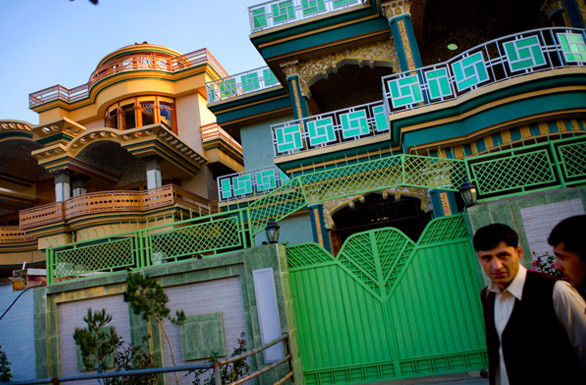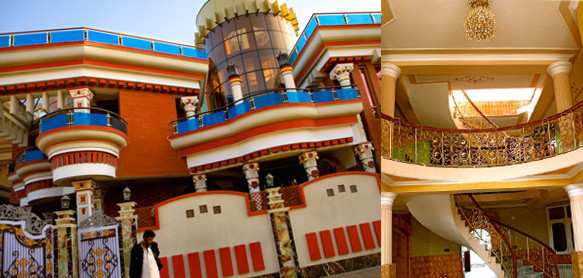By Tom Freston

The gargantuan homes of Kabul’s Sherpur district feature grand entrances, byzantine floor plans, and huge, cavernous hallways. Everything inside is concrete and marble—no Sheetrock here. (Photo: Zalmai Ahad)
“Just look at this view,” said my guide, as he waved his arm expansively from right to left. We had just emerged onto the sun-drenched roof terrace of a so-called narco-villa in Kabul’s Sherpur neighborhood. Sherpur is the epicenter of an eye-catching architectural style in a district where the gusher of money from drugs and corruption has found full expression. From the rooftop I look out on a jumble of grotesque, garish, candy-colored, multi-storied mansions sitting almost on top of one another. They resemble a mad baker’s window display of bad wedding cakes. These are the fortified castles of Afghanistan’s peculiar new elite. “Narco-tecture” takes classic design elements from ancient Greece and then goes psychedelic with them, adding touches from Mexico and Pakistan. Bad money has met bad taste in this former military installation in the suburbs of Kabul. If there were a Narco-tecture Digest, Sherpur could make up a special issue.
Sherpur had been army land, the site of an old fort surrounded by modest homes. In 2003, the government evicted many of the local families and distributed the land to cabinet ministers, the mayor, militia commanders, and various warlords. Here in a city where most people live in slums with no running water or heat, the government commandeered a new suburb for high rollers, an enclave borrowing more from Scarface than Scarsdale. According to some, there are about 75 narco-villas now in Sherpur. I had heard that their neighborhood association, so to speak, petitioned the U.N. to pave the streets, but the U.N. wisely refused. Still, the international community, ever the enabler in Afghanistan, has managed to rent quite a few of these monstrosities over the years as homes for news organizations, diplomatic residences, and guesthouses. For the owners, it’s a perfect scheme.
I’ve been intrigued by these structures ever since I returned to Afghanistan, in 2007. They just seemed so wrong, so blatant, so out of place. I’d read about the narco-tombs in Mexico—multi-story, pastel-colored, air-conditioned mausoleums built by drug lords there. I’d heard about their narco-wives, too. So I was eager to see these narco-villas. For my first visit to a real-estate office there, five years ago, I posed as a big-shot ex-pat renter and said I wanted to see some “very large homes.” These homes, also known as “Poppy Palaces,” can encompass 50 or 60 rooms. Rents were $25,000 to $100,000 a month back then. One, it was said, had “room for 50 cars.” I inspected four or five narco-villas, each bigger than the one before.

In 2007, these homes garnered rents of up to $100,000 a month. Today, news of the foreign-troop withdrawal has hit the market hard, dragging prices down 25 to 50 percent and leaving 30 percent of the houses unoccupied. (Photos: Left By Zalmai Ahad, Right by Tom Freston)
Narco-villas feature grand entrances, byzantine floor plans, and huge, cavernous hallways. Everything inside is concrete and marble. No Sheetrock defiles the space. There is very little wood trim, and the chandeliers and fixtures could be right out of Medellin. They say you can tell a lot about a home by the way it smells. These smelled unhealthy: cold and moldy. The upstairs floors are warrens of bedrooms with no attached baths. The real action, the un-Islamic action, if you will, is hidden away in the basements. Some have elevated swimming pools (in odd colors), large bars, and full gyms. I saw a room with hooks on the ceiling. I was told it had been a gym. A convenient place to hang someone with their arms behind their back, I thought. The most striking thing about these buildings is the vulgar detailing: the painted Greek columns, the mirrored fireplaces, the Bavarian Alpine murals.
I watched Sherpur boom over the years and then sadly began to notice narco-villas popping up everywhere in town, supplanting the far more sensible indigenous Afghan architecture. In Kabul’s hothouse real-estate market, every time you saw a teardown, you could bet another narco-villa was likely on the way.
The news that foreign-troop withdrawals would be completed by 2014 initially hit the real-estate market in Kabul very hard. Many wondered what will happen when nato forces leave and much of the foreign aid dries up. This October, five years after my initial visit, I headed back to see if the narco-villa market could be a leading economic indicator of the future.
There were “For Rent” signs all over Sherpur. “Many organizations have finished their jobs and left,” my guide told me. He added that about 30 percent of the homes are now empty. Prices are down by 25 to 50 percent. Of course, location still rules. From a rooftop my guide pointed out a villa on a corner lot. It used to go for $18,000 a month, but now you can get it for only $8,000. It’s on a corner, so it’s a bigger security risk, and after all, security is worse now. The narco-villa to its left, with the nice garden, has held its price, I’m told, because it’s next door to a big cheese from the Afghan Intelligence Directorate who has a huge security detail. It has 50 rooms, and the owner is holding to his $50,000-per-month rent. With so many people leaving, who might be moving in? “Blackwater’s coming; that’s about it,” said my guide, referring to the security firm now called Academi.
Architectural eras can provide a capsule history of a city. The rise of the narco-villa in one of the world’s poorest countries speaks volumes about what has gone wrong in Kabul. Architecture here was traditionally low-key and adaptive to the environment: cool in summer, warm in winter. These villas are just the reverse. And their design influences are quite foreign, drawing not from tradition but from movies that glamorize excess. But the impulses that built these homes are universal. If you suddenly come into some free land and some easy money, and if you’re without much refinement, then big and garish seems to be a good way to go. We sure have our own versions of that in the United States.
Looking down on these odd-looking mansions, it occurred to me that Afghanistan is a bit like Hollywood, a place where I have also spent time. Both have plenty of charming, outsize characters; there is an ever-changing and rapacious elite; business dealings can involve something a bit illegal and dangerous; money is rarely spent rationally; and there’s an endless line of outsiders ready to come in, caught up by the romance and the sense of possibility. Just like Hollywood, Afghanistan is a bit of an insider’s game. Most people eventually go home defeated and poorer. You’ll notice, though, that Hollywood has not disappeared. Neither will Afghanistan. It will do what it has always done: hunker down, sort out its own problems, and wait for new arrivals to devour.



